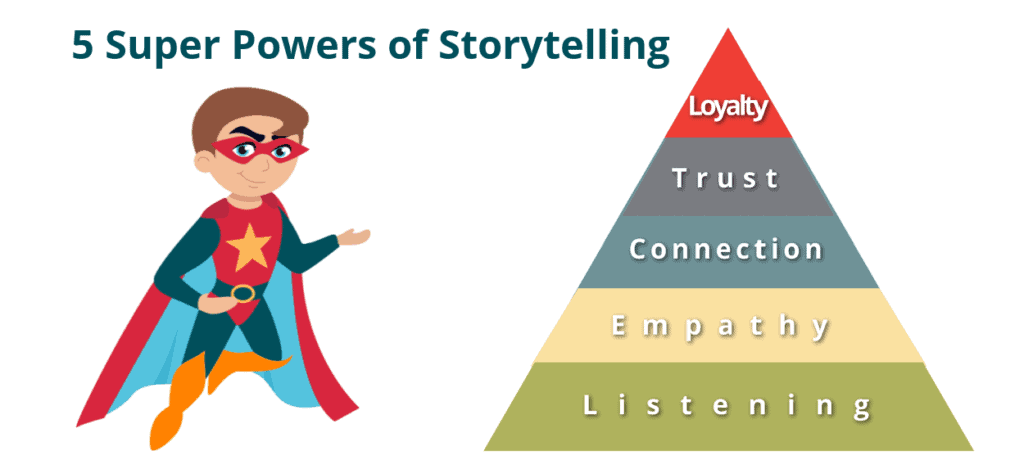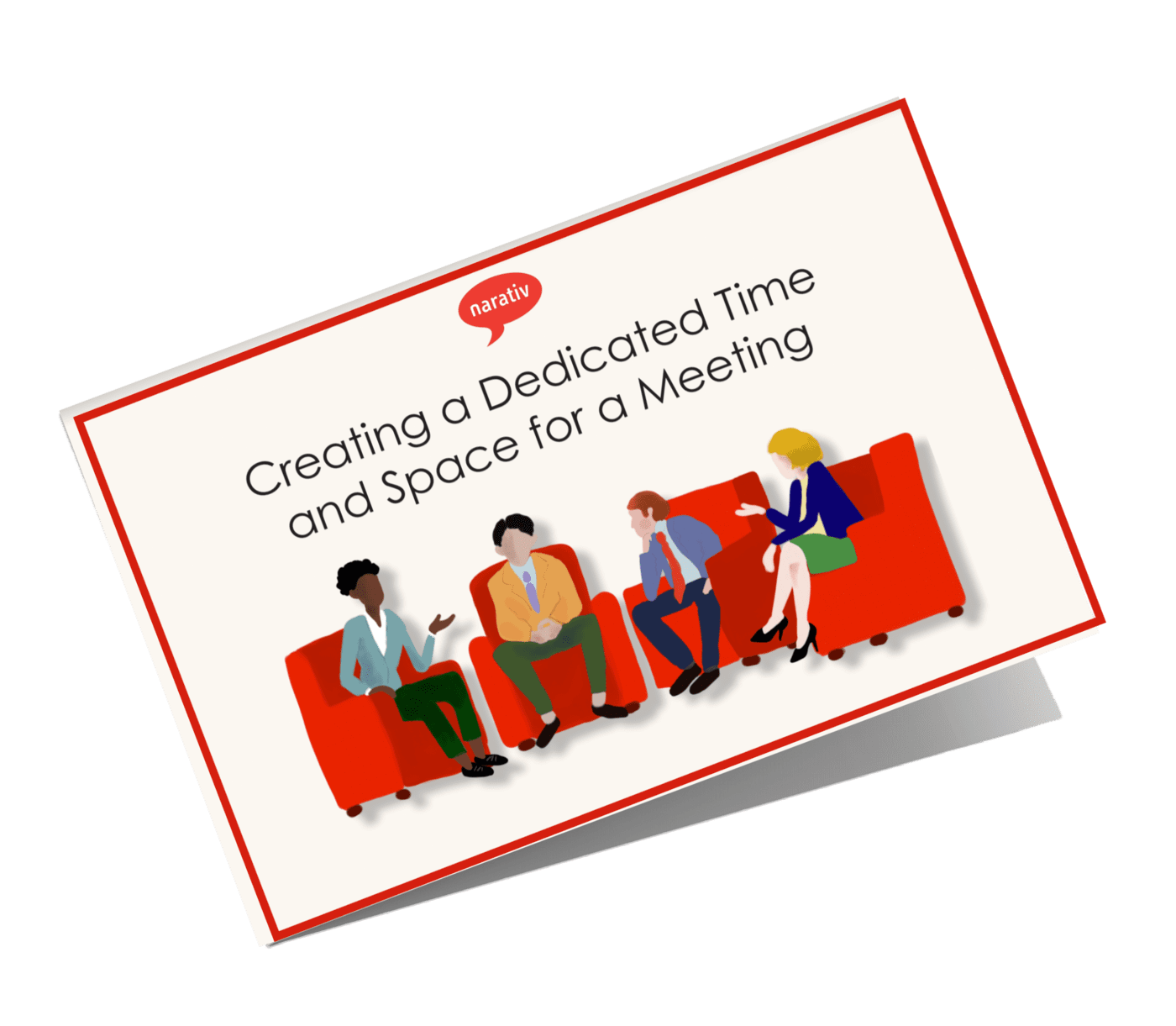Storytelling is one of the oldest facets of humanity, and it has been used across the millennia to connect people, make sense of problems, and teach important lessons. As our lives and issues evolve, so do our stories, and as new kinds of problems arise in our society, the best response is to meet them with new kinds of stories. At Narativ, our job is to identify the types of stories best suited to the needs of an evolving business world—and we’ve found that leadership storytelling is vital in the current business climate.

Since the height of the pandemic, there have been so many different changes across our working world that it can be hard to keep up. Virtual onboarding and hybrid workplaces have become commonplace, and on top of that, resignation rates are higher than ever. Additionally, leaders now have to consider a growing chorus of economists and business experts telling them that a global recession is on the way. Every day it can feel like there’s a new crisis, making it hard to respond to all the emerging needs and problems.
A Call for Transformation
Much of this stems from the fact that people aren’t satisfied anymore with the way things used to be run, and they are calling for change. This period of uncertainty can be intimidating, but it is also a perfect opportunity to redesign the work environment to be more engaging and help employees feel they are contributing to something larger than themselves. With all this change, we can now begin to move beyond factory productivity and make work into something that fits human beings.
New opportunities can be wonderful, but managing everything needed to navigate them can seem like a task far better suited to a superhero. Unfortunately, there aren’t any radioactive spiders or gamma rays that can power you through this 21st-century workplace shakeup, but at Narativ we believe that the superpowers needed to navigate all of these new challenges can be unlocked entirely through leadership storytelling.
What is Leadership Storytelling?
It may be a little confusing to hear that storytelling will make you into a better leader, but consider what a story does: A good story doesn’t just list details, but rather it creates an intimate space through which the teller can use experiences and emotions to show their audience who they are and why they do what they do.
You may be aware of the way that brand storytelling works to establish a company as trustworthy and people-oriented. Leadership storytelling works very much the same way but for an individual instead of a company. If you are in any sort of management or leadership position, it’s vital to learn to connect with your own story of why you do the job that you do—and then convey that story to others in a way that authentically demonstrates why you are a good person to work for.
The fundamentals of leadership storytelling also happen to be the 5 superpowers that will take your leadership—and the job satisfaction of your team—to the next level. So if you want to know how to improve your leadership skills, let’s put on our capes and talk about each of these 5 superpowers!
1. Listening
One of the first things we drive home to our clients during any of our story group training programs and one-on-one coaching sessions here at Narativ is that the reciprocal relationship between listening and telling is critical for good storytelling. That can be confusing for some people at first, but an interesting thing occurs when we take the time to listen. Drab facts and knowledge turn into wonderful stories. Lots of them. And not only that, but the listener(s) actually inform and have an affect on the telling of the story itself.
Think of a stand-up comedy act, for example. One night, the comic delivers his set and the audience is relatively quiet, not laughing very often. This response effects the performance (or telling) of the comic. His performance just continues to get flatter and more disconnected from the audience for the rest of his set. The very next night, the comic comes out and tells the exact same jokes but this time, the audience erupts into laughter after his very first one. The audience has shifted the energy in the room with their response, the comic can feel it and subsequently proceeds to deliver the rest of his show with well-timed jokes followed by more laughter and the symbiotic relationship continues through the entirety of his set.
It is even more pronounced with any kind of storytelling as it is in the space between listening and telling that innovative ideas get produced. The reciprocal relationship of listening and telling is all about giving and receiving and the formation of a dynamic created between the two.
This reciprocal relationship also can have a profound impact on transformation. In an episode of the Narativ Story Talks Podcast, our CEO, Jerome Deroy, discussed how he worked with a company in the wake of the death of George Floyd. The nature of their business did not allow their employees to park their concerns at the door, and the company wanted to show they were listening. As they listened, they heard stories, and from those stories, they learned. They then took this knowledge they’d gathered and used it to create a new story about their company. This new story highlighted what the company’s goals were and the type of work environment they envisioned while also addressing the concerns of their employees.
The result was a workspace that was more accessible and inclusive. Employees felt free to share their concerns without worry of it negatively reflecting back on them. This allowed for better communication and helped employees feel appreciated and cared for.
Listening like this helps to shape our stories. When we listen and respond, stories are shaped on both sides of the conversation. We can modify and adjust our own stories to fit more intrinsically with our audience, but we will only know how to adjust if we listen.
It all starts with listening—it’s the building block for all the other superpowers of leadership storytelling, and the key to unlocking the next superpower: Empathy.
2. Empathy
What is your leadership style? If you are going to be responsible for the training or management of others in any workplace, you’re going to have a much easier time knowing what leadership style to adopt if you first put in the effort to develop genuine empathy for the challenges facing your employees. The best way to develop this empathy is, of course, through storytelling.
It’s a simple fact that stories foster empathy. Multiple studies—including this one by Discover Magazine—have shown that reading fiction increases empathy. Researchers believe the opportunity to learn about other perspectives helps people understand one another and lessens hostility. But apart from starting a team book club, what can this insight offer your company? The important thing to note here is that, fiction or not, stories have a deep effect on people. When you use stories in your daily work and teach your people how to do the same, you’ll encourage more empathy in everyone.
As you seek to cultivate empathy, be sure to think through your own development as a leader. Consider some of your early experiences in a new workplace. Were your struggles listened to by a trusted supervisor who understood you or were you brushed off? Either way, you can apply the story of this experience to both shape your personal approach to leadership and show your employees that you understand and relate to their positions.
A study by the Center for Creative Leadership found that “empathy in the workplace is positively related to job performance.” It can improve communication and motivation while also helping your leadership understand the needs of their employees more intrinsically—particularly things like burnout and workplace dissatisfaction—to help you get ahead of the curve.
Through storytelling we have the chance to see the world through another’s eyes, even if only for a short time. By learning to empathize more effectively through leadership storytelling, something amazing naturally occurs: Connection.
3. Connection
When people understand one another they form a bond of connection. And, you guessed it—the most effective way to promote understanding and connection in the workplace is through storytelling.
Think about meeting up with old friends to reminisce about the good old days. That connection we feel is what makes that reminiscing so sweet. The same applies to the workplace. Whether it’s a story they’ve heard or one they experienced personally, stories build camaraderie.
A report by NPR quoted Uri Hasson, a professor of psychology at Princeton, who said, “As you hear a story unfold, your brain waves actually start to synchronize with those of the storyteller.” The connection is real and effective, and storytelling naturally builds it.
As leadership engages in storytelling with employees, they will build that connection as well because these interactions break down superficial barriers and cut right to the core of our humanity.
Along those lines, we often make assumptions about people, based on how they dress, talk, or act. When we engage in storytelling, those assumptions melt away and we can actively build connections with others. Suddenly, the hard edges soften and new understandings are reached.
In another episode of Story Talks, the hosts spoke with Sira Abenoza—founder of the Institute for Socratic Dialogue in Spain—who detailed exactly how fostering connection through storytelling and dialogue will drastically change the outcome of any problem-solving endeavor. No matter the issue, taking the time to listen and share will foster the kind of communication that is needed to spark change on any scale, whether it be in the workplace or the world at large.
Storytelling builds and strengthens all sorts of bonds, and one of those bonds is our next superpower: Trust.
4. Trust
Any effort we apply to building connections will also naturally establish trust. Once we’ve built those connections, we can continue to build deeper trust as we adapt our own stories to reflect what we have learned from the stories of others. With that trust, others will, in turn, follow our stories even closer and be willing to connect in ways they may not have previously.
Trust is built in many ways, largely by proving yourself trustworthy with your actions, but trust can also come from vulnerability. If you as a leader are willing to be vulnerable in your personal storytelling, it can help your employees see that you are someone who supports them in their experience of being human. If you can demonstrate through your storytelling that it is safe to show emotions, to make mistakes, and to struggle, then your employees will be able to trust that they are likewise free to learn and grow. A work environment built on trust will always produce better work.
Another aspect vital to building trust is, of course, honesty. Forbes shared that employees and audiences can tell when something doesn’t line up; however, they will trust companies that are transparent about themselves. And trust is a two-way street. As your leadership engages in storytelling not only will their employees grow to trust them, but your leaders will also grow to trust their employees more as well.
Over time, trust that is proven and strengthened grows into something even greater: Loyalty.
5. Loyalty
Loyalty comes when the previous 4 superpowers are developed and employed to create a psychologically safe workplace. When we are listened to, receive empathy, build connections, then have our trust proven, we feel appreciated; we feel as though we are being shown loyalty, and it’s only natural to return that feeling. The superpowers we’ve covered leading to this point are all the building blocks of loyalty: Loyalty to ourselves, loyalty to our leaders, and loyalty to our companies.
Another article by Forbes shares various ways to build loyalty in storytelling. One thing they noted was the importance of taking your time. A story shouldn’t be rushed. It should have time to resonate and sink in with your audience. The goal is to build loyalty through the story by taking the time needed to help your audience truly understand the narrative you are revealing and sharing.
Loyalty is the ultimate leadership superpower because storytelling naturally culminates in greater loyalty as employees and leaders alike share intrinsic parts of themselves through the medium of storytelling.
Donning Our Capes
By harnessing these aspects of leadership storytelling you can use the superpowers of listening, empathy, connection, trust, and loyalty throughout your leadership to empower your employees and strengthen your business.
The most effective way to lead is to lead by example. Once you have these powers at your disposal, your leadership will naturally help to foster them in others—whether they be your subordinates or your peers. If applied company-wide, other company leaders will likewise become equipped to foster these traits throughout every tier of your company to create a unity of purpose that is unshakeable.
The important thing to note is that while each of these superpowers is extremely valuable on its own, they are collectively so much more. When we pursue these powers through storytelling they flow intrinsically from one to another, and this interconnectivity makes it easy to build leaders who successfully employ all 5 to support your company and the employees within it.
If you are interested in unlocking these superpowers in your own company through business leadership training, check out our Business Storytelling Training page or book time directly with our CEO, Jerome Deroy, to discuss group and one-on-one coaching sessions for you and your leadership teams.




